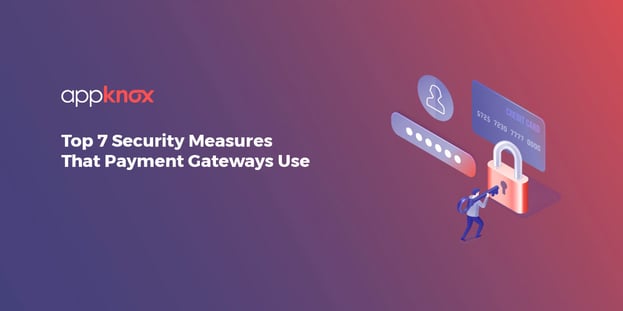
BLOG

BLOG
Payment gateways always consider sensitive data, compliance, and security when making decisions. However, technology is nowadays a double-edged sword. Just as digital advancement has revolutionized global commerce, so too have cybercriminals' tactics for defrauding merchants and customers.
A study by PWC, Global Economic Crime and Fraud Survey 2020, found that 47% of respondent companies experienced some form of fraud, resulting in US$42B of losses. Statista estimates that in 2021, cyber fraud alone accounted for over USD$20B, up from US$17.5B in 2020.Payment gateways ensure that merchants and their customers are safe and have all bases covered.
But what should merchants look out for when choosing the payment gateways with the best security standards?
In this article, we'll dive into the top 7 security measures that payment gateways use!
But first things first.
A payment gateway is a cloud-based software that connects merchants with customers. When a customer wants to pay in-store at a Point Of Sale (POS) or online through a webshop, the payment gateway will read and transfer the payment information from the customer to the merchant's bank account in seconds.
In addition to providing a seamless payment experience, fintech developers must ensure that their payment gateway is secure and adheres to industry standards.
While it may seem easy to merchants and customers, what happens behind the scenes of payment gateways is quite complex.
1. The customer starts the purchase, fills in their card details, clicks 'Buy,' or taps their card or mobile wallet onto a card reader.Payment gateways play a vital role in cracking down on fraud. We've all been the targets of fraudsters in one way or another, whether it's phishing emails landing in our inbox or our bank calling to verify our spending habits.
As we spend more time online, fraudsters have more opportunities to con honest people out of their cash, which is concerning to customers and costly for merchants. European retail webshops now face an average of 206,000 attacks from fraudsters monthly.
Fraud is evolving exponentially.
With e-commerce fraud forecasted to reach USD1.5 billion 2022 in Europe alone, merchants must invest in fraud management to ensure customer safety.
Luckily, financial fraud detection technology is constantly developing to monitor and detect fraudulent transactions in real-time and identify changes in behavior to spot bad actors.
In short, the takeaway is that merchants must continue to spend on e-commerce fraud detection systems boosted by AI and machine learning, which will improve the efficiency of detection and mitigation measures. Having the right payment gateway on your side is the best place to start.
.jpg?width=750&name=Top%207%20Security%20Measures%20That%20Payment%20Gateways%20Use%2040186_Infographic%20image%201_V1%20(1).jpg)
Payment Card Industry Data Security Standard, or PCI-DSS, is a set of compliance rules and security regulations implemented by the major card schemes. PCI-DSS compliance is a requirement for any business that processes credit or debit card transactions. Adhering to compliance schemes ensures a secure environment for credit and debit transactions without making details vulnerable to card theft and fraud.
Any business that accepts online payments must understand PCI-DSS standards to make the right choice when selecting a payment partner.
Encrypting data is the primary method payment gateways use to secure sensitive transaction data. When you enter your card details at the checkout, the payment gateway encrypts the data. Encryption turns the data into another form or code, so only people can access a secret key. The payment gateway will decrypt the transaction using its private key, drastically decreasing the possibility of the data falling into the wrong hands.
A secure socket layer, or SSL, is a security technology that creates a safe connection between a payment provider and a customer's web browser. Any data communicated via SSL is encrypted. All web browsers can have SSL.
If a website is processing a transaction directly, it should have SSL in place. However, this isn't a requirement if the website’s visitor is redirected to a secure checkout page on the payment gateway's domain, as the payment gateway will then provide the SSL link to the browser.
Secure electronic transaction (SET) is a system and electronic protocol that encrypts credit card payment data. Jointly designed by the major card schemes VISA and Mastercard, SET conceals all personal details on the card, which prevents fraudsters from accessing the information. SET also blocks merchants from seeing that personal data.
Tokenization converts the cardholder's sensitive data into a security token.
Creating a token involves hashing, encryption, and secret keys. As card schemes prevent merchants from storing card numbers unless they completely comply with PCI-DSS guidelines, having a payment gateway that uses tokenization is your best bet.
Tokenization increases security because sensitive information is only sent once over the internet. Once the token is created, it's used for future payment requests.
3D Secure 2.0 (3DS 2.0, 3DS2, or EMV® 3-D Secure) is an authentication protocol developed by EMVCo to address the issue of customer authentication in online payments.
Customers who enter their card details will receive an extra step to verify their payment with their bank, usually via a password. It provides the merchant and the customer an additional layer of protection against chargebacks and fraud - while facilitating a frictionless and seamless payment experience across different channels.
Of course, it's important to ensure everyone who processes payments knows the latest regulations and compliances.
Usually, regular training and exams are conducted internally to ensure that all employees know how to handle payment data effectively, what to do in a data breach, and how to effectively inform their customers. Having the right information in the employee knowledge base ensures everyone is on the right path to crack down on fraud.
Wherever there’s a lucrative opportunity, fraudsters won’t be far behind.
Crushing fraud shouldn’t be your end goal. Managing it quickly and precisely is essential to improving the customer experience and keeping conversions high.
Having the right payment methods on your side is the first step to ensuring the safety and security of your payment transactions.
